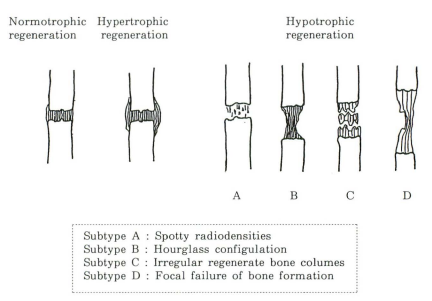Me: I wanted to go deeper into the research behind what types of surgical methods are available for limb lengthening and my searching is starting to lead me to some surgical methods I have not been aware of before. The new idea that I learned about is that of Callus Distraction, or Callotasis. It is important to realize that most forms of distraction osteogenesis operates on the callus principle. Limb Lengthening for orthopedic surgeons who specialize in the area is actually a very large area of study. There seems to be at least a dozen even more specific types of surgical methods for limb lengthening.
The Callus method means that after you make the distraction past the peristeum (why they call it subperiosteal) and past the cortical bone (why they call it submetaphyseal) you hold the two ends close to each other and let the bones heal and create a callus. The callus that is formed gets pulled before it starts to get hard adn inelastic from the calcium salts. Slowly more callus will develop from the distraction of the callus. You are supposed to keep the trabecular spongy bone and cavity intact.
From source link HERE
Clin Orthop Relat Res. 1989 Apr;(241):137-45.
The callotasis method of limb lengthening.
Source
Center of Pediatric Orthopaedics, Institute of Clinical Orthopaedics and Traumatology, University of Verona, Italy.
Abstract
Callotasis is a lengthening technique that involves slow, controlled distraction after subperiosteal-submetaphyseal osteotomy. The technique and its advantages over other methods are described. Results of lengthenings involving 270 operated bone segments (146 femurs and 124 tibias) in 140 patients are reviewed. Ninety-five patients had limb-length inequality and 45 had hypochondroplasia or achondroplasia. On average, 6.6 cm, or 24.6% of initial length, was gained. The mean healing index was 39; the complication rate was 13.3%.
- PMID: 2924457 [PubMed – indexed for MEDLINE]
- Me: It appears that callotasis is a very popular approach for people who have some form of dwarfism.
- From source link HERE
- J Pediatr Orthop. 1987 Mar-Apr;7(2):129-34.
Limb lengthening by callus distraction (callotasis).
Abstract
Callotasis is a new technique of limb lengthening involving slow distraction of the callus formed in response to a proximal submetaphyseal corticotomy. Using a dynamic axial fixator with telescoping capabilities, distraction begins after 2 weeks. When the required length is attained, the fixator is held in the rigid mode until radiographic evidence of callus is observed. The locking screw is then released, and dynamic axial loading is instituted to promote corticalization. One hundred bony segments have been lengthened; 50 patients had limb length inequality, and 23 had achondroplasia. The mean lengthening achieved was 22% (maximum, 58%). There were 14 complications (14%).
- PMID: 3558791 [PubMed – indexed for MEDLINE]
- From Ilizarov Jordan website
- Callotasis
a distraction osteogenesis technique that involves gradual stretching of the reparative callus, which forms around bone, segments interrupted by osteotomy or nonunion fracture. The main complications of this period are axial deformity of lengthening segment, pin tract infection and fixator unstability.
- From source link HERE
-
We can see the different ways the distraction can happen and what would happen if the distraction is done improperly at different speeds.

